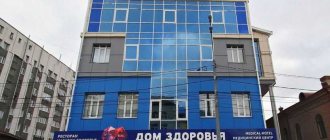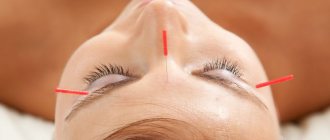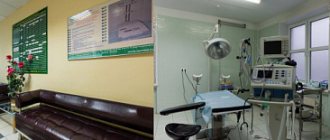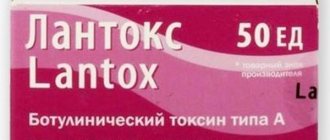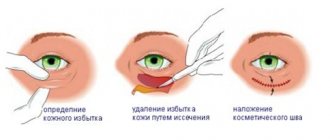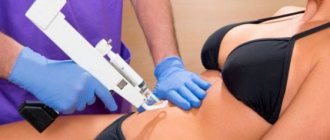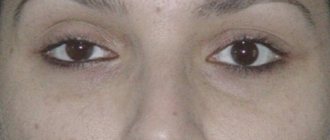We communicate with each other by looking into the other's eyes. They play a key role in communicating and connecting with each other, but unfortunately, the area around the eyes is also one of the first to show aging.
Signs of aging that affect the eyes include increased wrinkles, excessive folds of skin, and discrete bulges around the eyes (hernial sacs). Excessive loose skin in the upper eyes may droop and block the field of vision. The lower eyelids may also appear sagging. In general, they give a tired, puffy appearance to the face.
Blepharoplasty Surgery
Blepharoplasty (eyelid surgery) is surgery on the upper or lower eyelids to improve appearance and youth. This is the most common operation performed by cosmetic surgeons around the world.
During blepharoplasty, excess skin and fatty tissue is removed or redistributed around the eyes to create a youthful, fresh, and well-defined eye shape.
Upper blepharoplasty (upper eyelid surgery) may be performed to correct severe or swollen upper eyelids. Lower blepharoplasty (surgery on the lower eyelids) reduces wrinkles and hernial sacs. These are two different surgeries that help correct different aesthetic problems of the eyelids.
Please note that blepharoplasty does not correct dark circles under the eyes, drooping eyebrows, or crow's feet lines near the eyes. There are other aesthetic methods and procedures offered by NT Medicine Cosmetic Surgery that can help solve these problems.
Not sure if blepharoplasty is right for you?
Perhaps you think you may need more than one type of cosmetic surgery? Or are you interested in non-surgical ways to create a youthful look?
We recommend booking a consultation with Dr. Grigoryan, Salov, Kalashyan. With their experience and commitment to achieving the best results for you, you can work together to create a customized treatment plan that includes both surgical and non-surgical cosmetic procedures specifically designed for the look you would like to achieve. Call 58-88-28,20-50-88 to speak with our friendly staff and book a consultation with a doctor.
Please also see our list of general FAQs for more detailed information.
Clinic of Trichology and Aesthetic Medicine AMD Laboratories Yaroslavl
To preserve beauty, as well as to reduce the baggyness of the lower eyelids, eyelid surgery is performed, which is called an eyelid lift or blepharoplasty.
Indications for surgery are most often cosmetic. In older people, the upper eyelids often limit peripheral vision. This is also a reason to resort to blepharoplasty.
It is worth noting that blepharoplasty will not eliminate dark circles under the eyes, crow’s feet and other types of wrinkles. To achieve their elimination, complex therapy is necessary, which includes procedures such as laser resurfacing, all kinds of injections and lifting in the forehead area.
WHY DO EYELIDS AGE?
Over time, the firmness and elasticity of tissues decreases significantly. Accordingly, wrinkles appear in the lower eyelid area, “crow’s feet” appear behind the outer corner of the eye, and overhanging skin folds appear in the upper eyelid area.
In severe cases of skin atrophy in the area of the upper eyelids, thin and stretched skin hangs down in the form of a skin fold, which leads to overlap of part of the palpebral fissure. This manifestation of skin atrophy is called blepharochalasis.
Eyelid surgery is necessary primarily for people whose family has a history of drooping eyelids. Most often, symptoms appear after 35 years of age. The operation can be performed when the first signs of drooping eyelids appear, without waiting for the condition to worsen. Of course, those who decide to undergo surgery should not have any serious illnesses and expectations from the operation should be realistic.
Blepharoplasty will undoubtedly improve your appearance, but it may not lead to radical changes, including changes in facial structure or an absolutely ideal appearance.
Before surgery, you should be clear about your goals and discuss any concerns you have regarding the surgery and its results with your surgeon.
HOW LONG DOES THE EFFECT LAST AFTER EYELID SURGERY?
The postoperative effect lasts for at least 5-7 years. Blepharoplasty does not stop the aging process of the eyelids; no matter how much you would like, it will still continue after the operation.
PREPARATION FOR BLEPHAROPLASTY
Blepharoplasty is a surgical intervention, and therefore will be accompanied by changes in the area of the operation. First of all, you will need to arrange for relatives or friends to take you home after the operation and preferably stay with you for the first 24 hours. The first few days after blepharoplasty will undergo a healing process. You will need peace and restrictions in your actions, so make sure in advance that you can stay at home in a calm environment. It usually takes 6-8 months to fully recover from surgery. During this period, it is mandatory to follow all doctor’s recommendations and attend dressing changes. Observation is coordinated with the attending physician on an individual basis and all recommendations and prescriptions are strictly followed.
OPERATION ON THE EYELIDS
When performing blepharoplasty, local anesthetics are most often used. To avoid unwanted complications, be sure to warn your doctor about previous illnesses, surgeries, existing allergic reactions, and injuries. If serious diseases or contraindications are detected, blepharoplasty may be refused.
If surgical intervention is planned to correct the 4th eyelid, then first of all the doctor will begin to work with the upper eyelids. Incisions are made along the natural lines of your eyelids, through which the surgeon separates the skin from the underlying tissue and removes excess fat and/or muscle. Afterwards, an intradermal suture is placed, which will remain on the eyelids for a week.
There are several methods for performing lower eyelid surgery. One method involves the doctor making an incision inside the lower eyelid and removing fat. The incision is not visible. The surgeon can soften fine lines on the skin using a CO2 or erbium laser. Another method is to make an incision along the edge of the eyelashes. Through the incision, excess skin, fat and loose muscle are removed. After a short period of time, the cut line disappears. For an ideal effect, the surgeon may recommend laser resurfacing.
RECOVERY PROCESS AFTER BLEPHAROPLASTY
Sutures after blepharoplasty on the eyelids remain for a whole week. Swelling and/or bruising may occur after surgery. After a week or two, these postoperative manifestations disappear.
CAN THERE BE COMPLICATIONS AFTER BLEPHAROPLASTY?
Since blepharoplasty is a surgery, undesirable eyelid lift results or complications are rare but do occur.
Natural changes after blepharoplasty in the surgical area:
- hemorrhages in the eyelid tissue – up to 10 days;
- swelling of the eyelid tissues – increases for 2-3 days, then gradually subsides;
- temporary decrease in eyelid skin sensitivity – up to 4-6 months;
- Scars along the incision lines are formed within 6-8 months.
Blepharoplasty brief summary
What is Blepharoplasty : Blepharoplasty involves making small incisions through which excess skin and fatty tissue around the eyes are removed or repositioned to rejuvenate them.
Where it's done : Your facelift surgery will be performed at the brand new NT-Medicine clinic in Yaroslavl, a fully licensed and accredited day hospital that specializes in plastic surgery.
Duration of surgery : usually between 1-2 hours. It may be longer depending on which method is used (see below), the complexity of the surgery, or if the blepharoplasty will be combined with another type of surgery.
Type of anesthesia : local or general anesthesia.
Day surgery or hospital stay : usually 24 hours.
Estimated cost : varies depending on the type, complexity and duration of the procedure. After consultation with the doctor, you will receive a price quote indicating the cost of the procedure.
Blepharoplasty of eyelids
Anesthesiology and resuscitation
| Service code | Internal code | Name | Price, rub |
| B01.003.004.007 | 37.1.1 | Spinal anesthesia lasting up to 1 hour | 8 000 |
| B01.003.004.006 | 37.1.2 | Epidural anesthesia lasting up to 1 hour | 14 000 |
| B01.003.004.008 | 37.1.3 | Spinoepidural anesthesia lasting up to 1 hour | 20 000 |
| B01.003.004.009 | 37.1.4 | Total intravenous anesthesia up to 20 minutes | 6 000 |
| B01.003.004.009 | 37.1.5 | Total intravenous anesthesia from 20 minutes to 60 minutes | 12 000 |
| B01.003.004.010 | 37.1.6 | Endotracheal anesthesia from 1 hour to 2 hours | 20 000 |
| B01.003.004.010 | 37.1.7 | Endotracheal anesthesia from 2 hours to 3 hours | 26 000 |
| B01.003.004.010 | 37.1.8 | Endotracheal anesthesia from 3 hours to 4 hours | 34 000 |
| B01.003.004.010 | 37.1.9 | Endotracheal anesthesia from 5 to 6 hours | 58 000 |
| B03.016.011 | 37.1.10 | Express analysis of blood gases and electrolytes | 2 000 |
| B03.016.011 | 37.1.11 | Advanced express analysis of blood gases and electrolytes | 2 500 |
| B03.016.011 | 37.1.12 | Artificial ventilation for 12 hours | 7 200 |
| B01.003.004.010 | 37.1.13 | Endotracheal anesthesia up to 1 hour | 14 000 |
| B01.003.004.010 | 37.1.14 | Endotracheal anesthesia from 4 to 5 hours | 40 000 |
| B01.003.004.002 | 37.1.15 | Conduction anesthesia of the 1st category of complexity | 4 000 |
| B01.003.004.005 | 37.1.16 | Infiltration anesthesia (large volume or area) up to 30 minutes | 3 000 |
| B01.003.004.005 | 37.1.17 | Infiltration anesthesia up to 15 minutes | 1 400 |
| B01.003.004.004 | 37.1.18 | Application anesthesia | 1 000 |
| B01.003.004.009 | 37.1.19 | Drug sedation with hemodynamic monitoring | 3 000 |
| B01.003.004 | 37.1.20 | Prolonged regional anesthesia (days) | 8 000 |
| A11.12.001 | 37.1.21 | central vein catheterization | 10 000 |
| A11.23.002 | 37.1.22 | TAP TEST | 12 500 |
| A11.23.001 | 37.1.23 | Diagnostic spinal (lumbar) puncture | 3 500 |
| B01.003.004.007 | 37.1.1.2 | Spinal anesthesia from 1 hour to 2 hours | 14 000 |
| B01.003.004.007 | 37.1.1.3 | Spinal anesthesia from 2 hours to 3 hours | 17 000 |
| B01.003.004.007 | 37.1.1.4 | Spinal anesthesia from 3 hours to 4 hours | 20 000 |
| A11.23.003.001 | 37.1.2.1 | Placement of an epidural catheter | 8 000 |
| B01.003.004.006 | 37.1.2.2 | Epidural anesthesia from 1 hour to 2 hours | 17 000 |
| B01.003.004.006 | 37.1.2.3 | Epidural anesthesia from 2 hours to 3 hours | 21 000 |
| B01.003.004.006 | 37.1.2.4 | Epidural anesthesia from 3 hours to 4 hours | 24 000 |
| B01.003.004.006 | 37.1.2.5 | Epidural anesthesia from 4 hours to 5 hours | 28 000 |
| B01.003.004.008 | 37.1.3.1 | Spinoepidural anesthesia from 1 hour to 2 hours | 22 000 |
| B01.003.004.008 | 37.1.3.2 | Spinoepidural anesthesia from 2 hours to 3 hours | 26 000 |
| B01.003.004.008 | 37.1.3.3 | Spinoepidural anesthesia from 3 hours to 4 hours | 27 000 |
| B01.003.004.008 | 37.1.3.4 | Spinoepidural anesthesia from 4 hours to 5 hours | 30 000 |
| B01.003.004.009 | 37.1.5.1 | Total intravenous anesthesia from 1 hour to 2 hours | 20 000 |
| B01.003.004.009 | 37.1.5.2 | Total intravenous anesthesia from 2 hours to 3 hours | 24 000 |
| B01.003.004.010 | 37.1.9.1 | Endotracheal anesthesia from 6 to 7 hours | 65 000 |
| B01.003.004.010 | 37.1.9.2 | Endotracheal anesthesia from 7 to 8 hours | 70 000 |
| B01.003.004.002 | 37.1.15.1 | Conduction anesthesia of the 2nd category of complexity | 5 000 |
| B01.003.004.002 | 37.1.15.2 | Conduction anesthesia of the 3rd category of complexity | 6 000 |
Blepharoplasty
| Service code | Internal code | Name | Price, rub |
| A16.26.111 | 37.11.1 | Surgical correction of age-related changes in the periorbital area | 35 000 |
| A16.26.111.001 | 37.11.2 | Upper blepharoplasty (1 category) | 40 000 |
| A16.26.111.001 | 37.11.3 | Upper blepharoplasty with periorbital fat reduction, canthopexy (2 categories) | 50 000 |
| A16.26.111.001 | 37.11.4 | Repeated upper blepharoplasty, with epicanthal correction (category 3) | 80 000 |
| A16.26.111.003 | 37.11.5 | Lower blepharoplasty (1 category) | 50 000 |
| A16.26.111.007 | 37.11.6 | Lower blepharoplasty with periorbital fat reduction (category 2) | 80 000 |
| A16.26.111.003 | 37.11.7 | Repeated lower blepharoplasty, including correction of eyelid eversion (category 3) | 110 000 |
| A16.26.111.008 | 37.11.8 | Transconjunctival lower blepharoplasty (medial hernia) (1 category) | 50 000 |
| A16.26.111.008 | 37.11.9 | Transconjunctival lower blepharoplasty (medial and lateral hernias) (2nd category) | 70 000 |
| A16.26.111.008 | 37.11.10 | Transconjunctival lower blepharoplasty (medial and lateral hernias) (category 3) | 90 000 |
| A16.26.111 | 37.11.11 | Circular blepharoplasty (1 category) | 90 000 |
| A16.26.111 | 37.11.12 | Circular blepharoplasty (2 cat) | 120 000 |
| A16.26.111 | 37.11.13 | Circular blepharoplasty (category 3) | 150 000 |
| A16.26.111.005 | 37.11.23 | Correction of minimal age-related changes in the lower eyelids | 21 000 |
| A16.26.111.001 | 37.11.25 | Correction of minimal age-related changes in the upper eyelids | 21 000 |
General hospital services
| Service code | Internal code | Name | Price, rub |
| S01.001.001 | 37.0.1 | Stay in a hospital ward (daily) | 6 000 |
| S01.001.002 | 37.0.2 | Stay in a hospital ward (daytime until 21:00) | 3 000 |
| S01.001.003 | 37.0.3 | Stay in the ward for accompanying persons (daily) | 6 000 |
| S01.001.004 | 37.0.4 | Stay in hospital room VIP 1 (daily) | 10 000 |
| S01.001.005 | 37.0.5 | Stay in hospital room VIP 2 (daily) | 16 000 |
| S01.001.006 | 37.0.6 | Stay in a hospital ward (daily, without meals) | 3 400 |
| S01.001.007 | 37.0.7 | Stay in the intensive care unit from 6-24 hours | 8 000 |
| B01.047.009 | 37.0.9 | Supervision by a therapeutic physician (1 visit) | 2 500 |
| A11.12.003 | 37.0.10 | Infusion therapy of expensive drugs | 4 000 |
| A23.01.001 | 37.0.11 | Extraction of surgical material using delivery means (calculated price) | 1 000 |
| A18.05.013 | 37.0.22 | Treatment using blood products (calculation, price) | 1 000 |
| A11.12.003 | 37.0.23 | Treatment using additional drug therapy (calculation, price) | 1 000 |
| A23.01.001 | 37.0.24 | Selection of implants (calculation, price) | 1 000 |
| S01.002.001 | 37.0.25 | Selection of compression garments (calculation, price) | 1 000 |
| B01.057.001 | 37.0.28 | Appointment with an operating specialist | 0 |
| A11.01.014 | 37.0.29 | Hemostasis using local hemostatic agent Zhelplastan 2.5 g | 6 600 |
| A11.01.014 | 37.0.30 | Hemostasis using local hemostatic agent Zhelplastan 5.0 g | 12 700 |
| A11.12.003.002 | 37.0.31 | IV drip infusion of Ferinject 500 mg (Ferinject, 50 mg/ml, 2 ml No. 5 in ampoules or 50 mg/ml, 10 ml in a bottle), duration up to 30 minutes | 8 000 |
| А11.12.003.003 | 37.0.32 | IV drip infusion of Ferinject 1000 mg (Ferinject, 50 mg/ml, 10 ml in bottle No. 2), duration up to 30 minutes | 15 000 |
| S01.001.008 | 37.0.1.1 | Stay in a hospital room (overnight) | 3 000 |
| S01.001.009 | 37.0.4.1 | Stay in hospital room VIP 1 (no more than 12 hours) | 5 000 |
| S01.001.010 | 37.0.5.1 | Stay in hospital room VIP 2 (no more than 12 hours) | 8 000 |
Consultation on blepharoplasty
Can I undergo blepharoplasty?
Blepharoplasty is usually performed on candidates over 35 years of age. You must be in good general physical and mental health to have surgery and ideally be a non-smoker or able to quit smoking before surgery.
Who is a good candidate for blepharoplasty?
The ideal candidate is someone who has realistic expectations of what surgery can achieve and goes into surgery for themselves and not for anyone else (eg pressure from partners or family.
It is important to understand that cosmetic surgery performed by a doctor is performed with grace, with the goal of creating a subtle yet noticeable natural and elegant appearance. Good cosmetic surgery whispers, not shouts!
What to expect during your consultation?
No two faces are alike. After taking your general medical history, your doctor will carefully analyze your eyelids and discuss your concerns with you. He will then suggest a procedure or procedures specifically designed to address these issues and give you a balanced and rejuvenated appearance. For an accurate analysis of your face and eyelids, please avoid makeup or sunscreen during your consultation. It is also recommended that, where possible, you bring clear photographs of your younger self to your appointment. These images help the doctor understand the youthful contours of your face and eyes, as well as the results you want to achieve, so he can adjust your surgery accordingly.
Please note that the doctor will take photographs of your face and eyelids. Photography is vital in cosmetic surgery and allows the doctor to document and share with you your results before and after surgery. Sometimes these photos will be uploaded to our website. Images are de-identified, removing birthmarks, tattoos and other identifying features. Images are not otherwise modified to show a true impression of likely results. Before-After images like these help other potential patients like you decide if this procedure is right for them.
Typically, the consultation is your opportunity to ask the doctor any questions or clarify any questions you may have about your blepharoplasty surgery.
What is the cost of blepharoplasty? What's included?
The cost of blepharoplasty surgery depends on the duration and complexity of the operation. After your consultation, once you decide that you are interested in blepharoplasty, you will receive a quote for the cost of the procedure. This price includes doctor's fees (surgeon fees) and the cost of follow-up visits up to 3 months after surgery. This does not include hospital and anesthesiologist costs, but an estimate of such costs can be provided upon request.
Blepharoplasty procedure
How is blepharoplasty performed? Are there different techniques?
There are three main types of blepharoplasty that can be performed. The doctor has the experience to perform any of these:
1. Upper blepharoplasty (upper eyelid surgery): Removal of excess skin and tissue from a severe or swollen upper eyelid that can cause vision problems.
2. Double Eyelid Surgery : Also known as Asian Blepharoplasty, it involves creating a higher eyelid, resulting in a natural looking double eyelid that matches the shape of the eye.
3. Lower Blepharoplasty (Lower Eyelid Surgery): The skin of the lower eyelid is tightened to correct wrinkles, sagging and sagging. Fat is often moved to the lower eyelid to correct hollows or bags under the eyelid.
Where will the incisions/scars be?
Depends on the types of blepharoplasty. In upper blepharoplasty, an incision is placed in the crease of the eyelid. In lower blepharoplasty, an incision is made either inside the eyelid or just below the lower eyelashes. In both cases, these incisions usually fade, forming faint, rarely visible white scars, although the degree of fading varies depending on how your skin tends to heal and scar.
What type of anesthesia will be used?
The type of anesthesia can be:
- Local anesthesia (where you are awake but a medicine is injected into the procedure area, making the area numb and comfortable throughout the operation. Local anesthesia also provides pain relief for several hours after the procedure).
- General anesthesia (this means you will be asleep during surgery and may need to be monitored for a longer period of time after the procedure). This is done by a qualified anesthetist who then looks after you during your procedure.
- The type of anesthesia chosen for your procedure depends on the type and complexity of your blepharoplasty surgery.
What are the side effects of blepharoplasty surgery?
Temporary discomfort, tightness of the eyelids, swelling, bruising. Temporary dryness, burning, itching in the eyes. Excessive tearing, sensitivity to light during the first few weeks. These are normal after blepharoplasty, and most of these symptoms resolve within two weeks after surgery.
What are the risks and complications of blepharoplasty surgery?
There are risks associated with any surgical procedure, and most problems are easily treatable and resolve over time. Generally speaking, cosmetic surgery is quite safe as it is sought after by healthy and fit people looking to improve their appearance.
Common risks of any surgery include excessive bleeding, reaction to any of the medications (including anesthesia), infection, poor healing, or excessive scarring.
There are also risks and complications associated with blepharoplasty, such as temporary blurred or double vision, swelling at the corners of the eyelids, dry eyes, or slight asymmetry between the eyelids. Due to swelling, it may be temporarily difficult to close the eyes completely. Sometimes blepharoplasty can cause drooping of the lower eyelids, requiring additional surgery.
The occurrence of such complications depends mainly on whether you smoke, your general health, how your body is healing, and your post-operative recovery. Your doctor will discuss the risks and complications with you during your consultation, as well as methods and medications that can minimize the risks.
Blepharoplasty
What you didn't know about blepharoplasty
- What time of year can you have blepharoplasty? The result of the operation does not depend on seasonality, summer is no exception!
- How many operations will be required? Correction of the lower and upper eyelids is performed in one operation.
- When is blepharoplasty prescribed? Blepharoplasty is prescribed for both age and aesthetic reasons.
- Will the shape of the eyes change? The shape of the eyes will not change after blepharoplasty.
- Are vision problems a contraindication? Blapharoplasty can be done even with reduced vision.
- How many times can an eyelid lift be done? Blepharoplasty can be performed many times if indicated.
- How much does blepharoplasty cost in Pyatigorsk? The cost of an eyelid lift is 15,000 rubles for each eyelid. Circular blepharoplasty costs 60,000 rubles .
Are scars noticeable after eyelid surgery?
Anyone who has decided to undergo eyelid surgery is concerned about the question of whether scars may remain after blepharoplasty. However, this operation should not be a cause for undue concern. ⠀ Many patients believe that scars after blepharoplasty will disappear completely in 1-4 weeks. And if this does not happen, then the patient begins to panic. Any scar takes time to completely tighten and smooth out on the surface of the skin. ⠀ After blepharoplasty, scars heal in several stages. It will take about 10-12 weeks for them to completely heal and “even out” the color with the shade of the surrounding skin. This does not mean that the marks from the operation will be too noticeable for the entire 10 weeks: you can disguise them with cosmetics, but most likely these measures will not be useful to you. ⠀ Lateral scars, located near the outer corner of the eye, are usually more noticeable than other incisions after blepharoplasty, but their condition improves noticeably after a few weeks. ⠀ Thus, at least 2-3 months should pass before the marks after eyelid surgery are completely healed. ⠀ In the first 4 weeks after blepharoplasty, scars go through the granulation phase, when new connective tissue with small vessels is formed at the site of the incision. And by the end of the first month, the incision site turns into a pink scar. Over the next 1.5 months, the scar turns into a white thin line that barely protrudes above the surface of the skin. ⠀ The patient makes the decision to undergo blepharoplasty together with the doctor, only he can give an opinion on the possibility of this surgical intervention.
Treatment of hernias under the eyes
Every fifth person has hernias (bags) under the eyes. As a rule, they do not bother a person at all, rarely affecting the quality of vision. Hernias look very unattractive: they age the face and give it a tired look.
⠀ Hernias under the eyes occur due to the anatomical features of the eye socket or natural aging of the body. The skin under the eyes is very thin and therefore loses its elasticity over the years. Bags under the eyes appear due to the release of fatty tissue beyond the boundaries of the eye orbit. ⠀ What reasons influence the appearance of bags under the eyes:
- metabolic disease;
- skin diseases;
- stress, insomnia, overwork;
- alcoholism, smoking, unhealthy diet;
- exposure to UV rays;
- eye cosmetics;
- paresis, paralysis of the eyelids;
- circulatory disorders;
- genetic factor.
⠀ Most often, hernias occur under the eyes in women and men over 30 years old. It is almost impossible to hide them with cosmetics. ⠀ The most effective way to eliminate hernias under the eyes is blepharoplasty, which not only tightens the skin of the eyelids, but also partially removes fatty tissue. For many, it is the only effective way to get rid of hernias and swelling of the eyelids.
Contraindications for blepharoplasty
Blepharoplasty surgery is carried out only in the absence of contraindications, for example: • inflammatory diseases of the body, including the eyes; • uncompensated diseases (diabetes mellitus, hypertension, coronary heart disease, etc.); • systemic blood diseases; • pregnancy and menstruation.
If it is possible to eliminate contraindications, then after the end of the rehabilitation period you can begin examination and preparation for blepharoplasty surgery.
Tips for a speedy recovery
Have you had blepharoplasty? - This means that you have approached the most important stage of treatment - the rehabilitation period. The doctor's job may be excellent, but the patient's compliance with the recommendations plays an important role. ⠀ How to behave during this difficult period:
- sleep on a high pillow;
- use recommended medications (drops, ointments, etc.);
- drink more water;
- reduce the amount of salt you consume;
- do not rub your eyes, avoid getting soap and shampoo on the skin around your eyes);
- avoid intense work and psychological stress;
- in the first 14 days, avoid the use of alcohol and tobacco;
- try to give up coffee, strong tea and energy drinks;
- your doctor may prescribe you therapeutic massage and eye exercises.
As for the upper eyelids, postoperative scars are located in the natural folds of the skin and are invisible to the ordinary eye. However, at the end of the recovery period, a laser scar resurfacing procedure can be performed.
What not to do after blepharoplasty surgery:
- touch eyes, stitches;
- wash your face during the first week;
- sleep face down or without a pillow;
- use cosmetics;
- use contact lenses;
- exercise;
- visit the bathhouse, sauna, solarium;
- being in the sun without sunglasses;
- self-medicate.
Take these recommendations responsibly; now it depends on you what the final result of the transformation will be.
Recovery after blepharoplasty
Face and wound care
The NT-Medicine Clinic will provide you with detailed instructions on how to care for your stitches, wounds, etc. Any stitches will usually be removed within 7 days. Your scars may need to be taped to improve treatment and their appearance.
Downtime
Returning to work takes 10-14 days, depending on the type of work you do. More strenuous activities (eg, lifting, straining, exercise beyond a light walk) should be strictly avoided for 4-6 weeks.
When will you see results?
Results will be visible as your tissues heal and swelling and bruising begin to subside, which can take up to a month or more. Therefore, patience and optimism are the keys to recovery after blepharoplasty.
What will be your follow-up schedule?
The doctor will see you a week after surgery and then arrange follow-up care based on how you are recovering. All follow-up visits up to three months after surgery are included in the cost of the operation. Revision surgery for any complications is carried out at an additional cost.
As during your consultation visit (above), the doctor will take photographs of your face and eyelids to document healing during subsequent visits.
